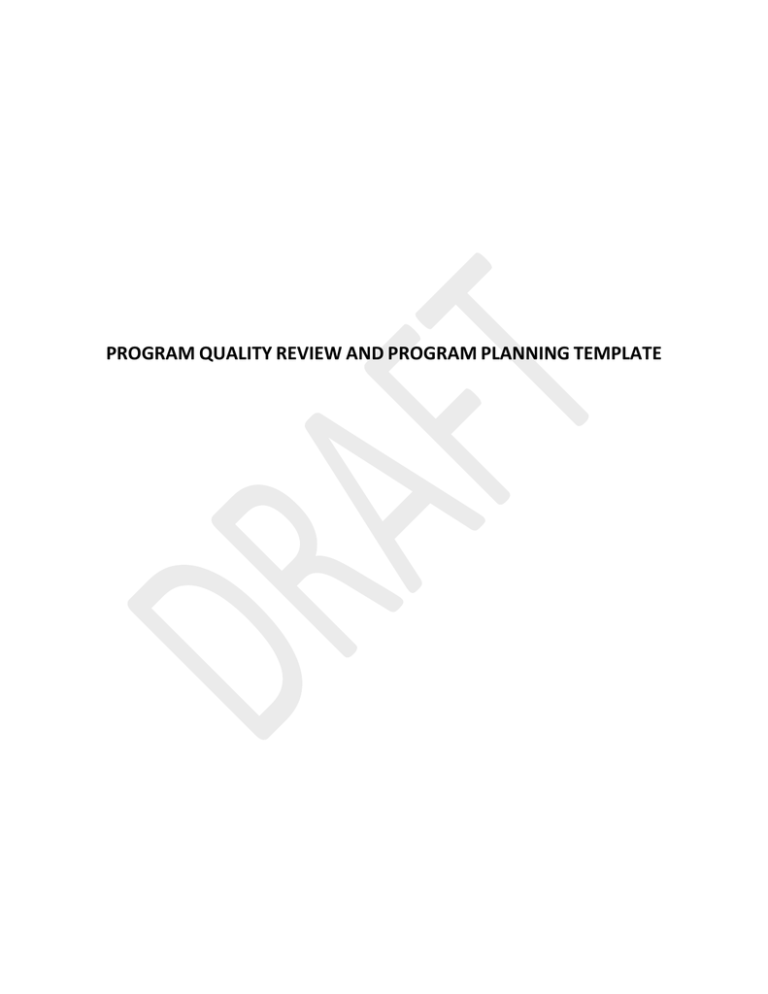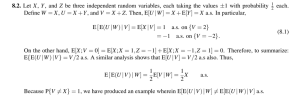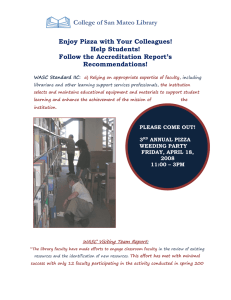PROGRAM QUALITY REVIEW
advertisement

PROGRAM QUALITY REVIEW AND PROGRAM PLANNING TEMPLATE COVER PAGE FORMAT 1. Name of Degree (e.g., Statistics, B.S.): 2. Department: 3. College: 4. Department chair/head: a. List name, mailing address, telephone number, fax number, and email address for the primary pre-visit contact person for the program b. Program/department website URL 5. Faculty Program Plan leader(s): 6. External Reviewer names and affiliations: 7. Date of this Program Plan: 8. Program review process contact: Jinny Rhee, Chair Program Planning: jinny.rhee@sjsu.edu a. Undergraduate Studies b. Nicole Loeser, Catalog, Curriculum and Program Analyst, UGS Special Note: this template is designed to help you through the Program Planning process. If an area does not pertain to your department/program, please do not delete it. Instead, place “not applicable.” 2 of 17 TABLE OF CONTENTS 1. STANDARD INFORMATION a. Institution b. College c. Program 2. SUMMARY OF PROGRESS, CHANGES, CHALLENGES, PROPOSED ACTIONS a. Progress on action plan of previous program review b. Significant changes to the program and context c. Strengths and achievements d. Challenges and concerns e. Recommendations and proposed changes 3. PROGRAM DESCRIPTION a. Program mission and goals b. Program learning objectives c. Curriculum description and alignment d. Service courses e. Proposed changes and improvements 4. ASSESSMENT OF STUDENT LEARNING a. Assessment plan b. Assessment results c. Interpretation and use of assessment results d. Proposed changes and improvements 5. STUDENT SUCCESS MEASURES a. Enrollment, retention, graduation, and placement trends b. Student, alumni, and employer feedback c. Student advising and support d. Student tutoring/support (if applicable) e. Proposed changes and improvements 6. PROGRAM RESOURCES a. Faculty b. Support staff c. Facilities d. Proposed changes and improvements 7. FOCUS THEMES a. Program-specific theme/mission b. Institutional theme/mission c. CSU theme/mission d. Proposed changes and improvements 3 of 17 8. APPENDICES CONTENT a. Required Data Elements b. (Example) Curriculum flow charts, and mappings c. (Example) Assessment rubrics d. (Example) Student success data summary e. Other (as determined by the program) SPECIAL NOTE: Report should not exceed 25 pages excluding appendices. 4 of 17 1. STANDARD INFORMATION (2-pages) a. Institution Include a brief narrative summarizing the mission of the institution b. College Include a brief narrative summarizing the mission of the college of the program and how it aligns with the above c. Program Year program implemented Department website link Program mission statement Complete list of programs offered in the department including minors Complete list of other programs served by courses provided by this department Number of faculty, instructors, lecturers, and support staff Number of students enrolled Approximate % of teaching effort at undergraduate level Approximate % of teaching effort to non-majors Total operating budget (including expenses) Location of department and faculty offices List of specialized facilities, if any Accrediting or similar agency, if applicable Date of most recent program review/accreditation/certification visit Date of any other recent peer review d. Process Outline or briefly describe the process used by the faculty to select the program-specific theme, if applicable Outline or briefly describe faculty engagement in the program review process including selection of reviewers, involvement in the self-study stage, departmental discussions, etc. 2. SUMMARY OF PROGRESS, CHANGES, CHALLENGES, PROPOSED ACTIONS (2– 3 pages) a. Progress on action plan of previous program review Briefly summarize the progress on the action plan of the previous program review b. Significant changes to the program and context Describe any significant changes to the program and the context since the last review c. Strengths and accomplishments Summarize strengths and accomplishments of the program d. Challenges and concerns 5 of 17 Summarize the challenges and concerns of the program e. Proposed changes and recommendations Outline the proposed changes, action timeline, and responsibilities Summarize recommendations of the program and proposed changes 3. PROGRAM DESCRIPTION (4 – 8 pages) a. Program mission and goals Summarize the program mission Summarize the overall future career and life goals that the program is preparing its graduates to be able to achieve o Undergraduates: o Graduates: Indicate whether the primary teaching effort of the department is for this program or in service to other programs b. Program learning objectives List the program learning objectives o If the program learning objectives have been established since the previous program review, describe the process of their development and adoption, and those who participated internally and externally in that process Describe how these program learning objectives are formally communicated to students, e.g. website, printed materials including advising materials, course syllabi, or other Describe any changes to the program learning objectives since the previous program review and the basis for those changes Summarize the program’s self-assessment of the program learning objectives using the WASC Program Learning Outcomes rubric. Produce a map that shows how the program learning objectives relate to the university learning objectives Produce a curriculum map that shows how the program learning objectives relate to curriculum courses c. Curriculum description and alignment Describe any successful curriculum changes or innovative ideas Describe any options, tracks, concentrations, etc., and any special modes including on-line and web-based instruction Produce a map that illustrates how the curriculum and significant co-curricular activities correlate with the university learning objectives Describe how the program learning objectives are implemented into the curriculum over time Describe how the University Learning Objectives are implemented into the curriculum over time 6 of 17 Describe how co-curricular learning experiences relate to the with learning objectives over time d. Courses in service to other programs If the department provides courses to other programs, list/tabulate courses or sequences of courses and programs served Describe the formal structures that enable the needs of those dependent programs to be regularly incorporated into the design and regular update of these courses e. Proposed Changes and Improvements Outline any proposed changes and improvements to: o Program mission and goals o Program learning objectives o Curriculum and its alignment with the learning objectives o Service role of the department 4. ASSESSMENT OF STUDENT LEARNING (5 – 10 pages) a. Assessment Plan Give an overview of the assessment plan including o the schedule used for assessing each of the learning objectives o responsibilities for continued data collection, analysis, interpretation and reporting o formal process of how results of assessment are used by faculty Summarize how each of the program learning objectives and university learning objectives are assessed, identifying direct and indirect methods, and describe performance standards expected of students [Insert any rubrics used by the department]. Briefly describe any assessment conducted on a senior project course, or equivalent capstone or other culminating, educationally integrating experience. Briefly describe any assessment that incorporates the use of portfolios Describe any surveys of current students, alumni, employers, etc. Provide a self-assessment by faculty of the program’s assessment process using the WASC Program Level Assessment rubric. b. Assessment results Summarize and interpret the assessment results collected since the previous program review describing levels of student attainment for each learning objective Describe any program, curriculum, and/or course changes made due to the assessment results Describe what has been done or is being planned in response to gaps, if any, in student achievement Describe (but do not include) any student work that will be available to the external reviewing team at the visit (or if accredited, what was available) 7 of 17 c. Proposed changes and improvements Outline proposed changes and improvements to o Assessment process o Assessment methods o Curriculum and courses 5. STUDENT SUCCESS MEASURES (4 – 8 pages) a. Key trends, enrollment, retention, graduation, placement trends, and other indicators Summarize and interpret the key trends (insert data tables from required data elements) Summarize and interpret program trends in regards to enrollment, first-year retention, graduation, average time-to-degree rates, and placement of graduates b. Student, alumni and employer feedback Summarize results of any student satisfaction surveys on the educational effectiveness of instruction, co-curricular and extra-curricular activities Summarize any alumni feedback on the educational effectiveness of the program Summarize any employer feedback on the quality of graduates of the program c. Student advising Report and comment on the student-to-advisor ratio Describe the formal processes including faculty (and/or peer advising) and staff roles of how students are advised for their course selection and preregistration, and career guidance Summarize results of any student satisfaction surveys and other feedback on advising Critically comment on the student advising structure, roles, quality, and resources d. Student tutoring Describe the options available for student tutoring Critically comment on the student tutoring structure, roles, quality, and resources e. Proposed changes and improvements Outline proposed changes and improvements to o Student success trends o Educational effectiveness o Student advising o Student tutoring 8 of 17 6. PROGRAM RESOURCES (2 – 4 pages) a. Faculty Comment on student to faculty ratios, faculty demographics, diversity, etc. Summarize the accomplishments of the whole faculty in relationship to: o teaching and learning o scholarship o service to their profession, community, and university o other forms of professional growth b. Support staff Report and comment on faculty to support staff ratios, etc. Report and comment on department, college, and university staff support including advising, tutoring, supplemental instruction, Information Technology (IT), etc. c. Facilities Report and comment on program facilities Report and comment on college and university facilities d. Proposed Changes and Improvements Outline any proposed changes and improvements to resources 7. FOCUS THEMES (3 – 6 pages) a. Program-specific Theme (Mission) Summarize the program specific focus theme if different from institutional theme Describe the process and methods faculty used to select and then study the theme Outline the analysis used Summarize the conclusions and recommendations of the faculty on the theme b. Institutional Theme – Senior Project (or similar culminating experiences) Describe the program’s senior project, capstone or culminating experience course(s) Outline the assessment methods and rubrics used to evaluate student achievement Summarize the results obtained Report on faculty self-assessment of the program senior project or equivalent using the WASC Capstone rubric Summarize the conclusions and recommendations of the faculty on the theme c. CSU Theme – For four year undergraduate programs exceeding 120 units Indicate when was the most recent reduction in total units required for graduation Explicitly identify the constraints on reducing the number of units further For programs without free electives, describe the constraints that prevent free electives 9 of 17 d. Proposed Changes and Improvements Outline proposed changes and improvements to the program, curriculum, resources needed for each of these themes 8. APPENDICES CONTENT (Suggested) When students graduate from San José State University they should be able to (based on WASC rubrics): Think critically and creatively Communicate effectively Demonstrate expertise in a scholarly discipline and understand that discipline in relation to the larger world of the arts, sciences, and technology Work productively as individuals and in groups Use their knowledge and skills to make a positive contribution to society Make reasoned decisions based on an understanding of ethics, a respect for diversity, and an awareness of issues related to sustainability; And engage in lifelong learning The Diversity Learning Objectives and the Sustainability Learning Objectives are expansions of the University Learning Objectives. Diversity Learning Objectives o o o o Demonstrate an understanding of relationships between diversity, inequality, and social, economic, and political power both in the United States and globally Demonstrate knowledge of contributions made by individuals from diverse and/or underrepresented groups to our local, national, and global communities Consider perspectives of diverse groups when making decisions Function as members of society and as professionals with people who have ideas, beliefs, attitudes, and behaviors that are different from their own Sustainability Learning Objectives o o o o Define and apply sustainability principles within their academic programs Explain how natural, economic, and social systems interact to foster or prevent sustainability Analyze and explain local, national, and global sustainability using a multidisciplinary approach Consider sustainability principles while developing personal and professional values 10 of 17 a. Catalog description, curriculum flow charts, and maps Catalog description of program o Copy from or link to on-line Catalog Curriculum flow chart o Include a curriculum flow chart showing prerequisite structure of courses, identifying those required and elective Mapping o Program learning objectives to curriculum courses o University Learning Objectives to curriculum courses o General Education (GE) to University Learning Objectives b. Assessment rubrics Include any rubrics that were used by the program during the Program Planning process Links to WASC rubrics: WASC Rubric on Academic Program Learning Outcomes (PDF), WASC Capstone Rubric (PDF) 11 of 17 <date of report> <Name of degree> APPENDIX C: WASC Program Learning Outcomes Rubric 12 of 17 WASC PROGRAM REVIEW RUBRICS <date of report> <Name of degree> Link back to Program Description section. 13 of 17 WASC PROGRAM REVIEW RUBRICS <date of report> <Name of degree> APPENDIX C: WASC Program Level Assessment Rubric Link back to Assessment of Student Learning section. 14 of 17 WASC PROGRAM REVIEW RUBRICS <date of report> <Name of degree> APPENDIX C: WASC Capstone Rubric 15 of 17 WASC PROGRAM REVIEW RUBRICS <date of report> <Name of degree> 16 of 17 WASC PROGRAM REVIEW RUBRICS <date of report> <Name of degree> Link back to Focus Themes section. 17 of 17 WASC PROGRAM REVIEW RUBRICS


